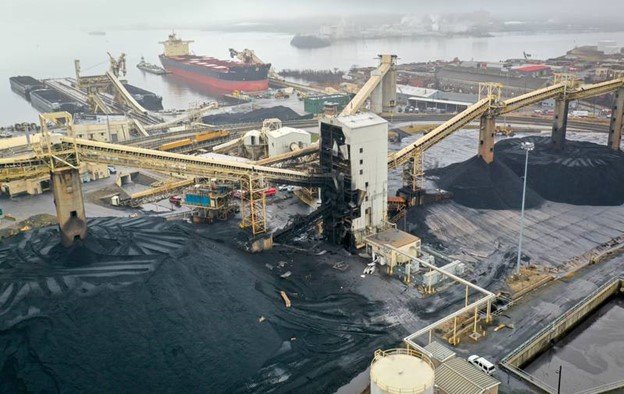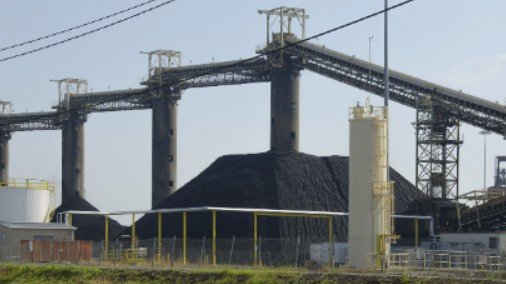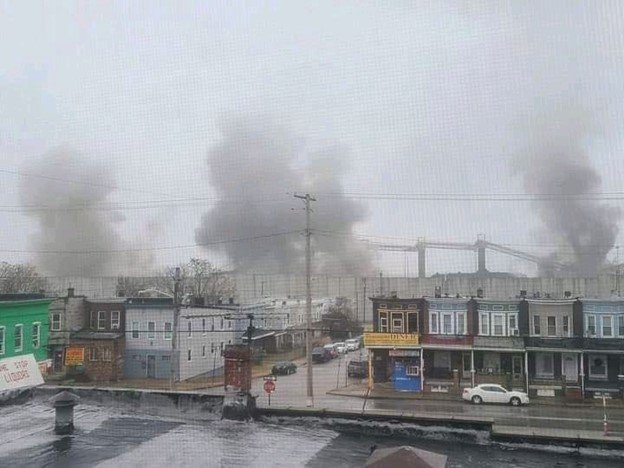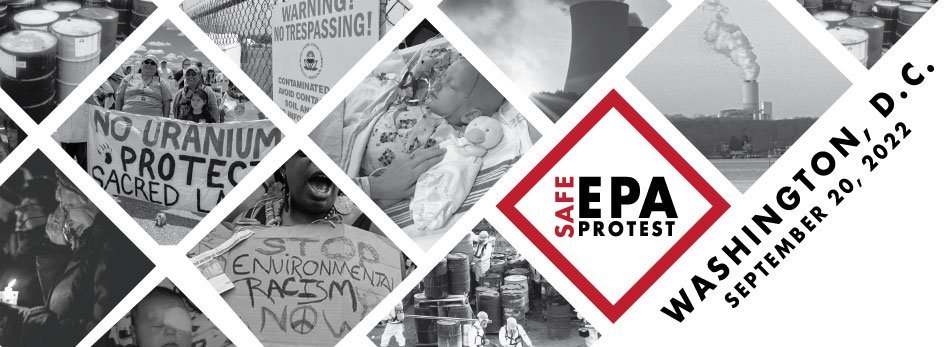Curtis Bay, Baltimore explosion reveals CSX influence
Under-reported December 30, 2021 fireball sends toxic coal dust that covers neighborhood of rowhouses
City, state, and federal agencies turn their back on community
By Pat Elder
September 4, 2022
Heavy damage is seen on the coal transfer tower and north tunnel of the CSX Curtis Bay Pier after a massive fireball exited the building during an explosion on December 30, 2021. Coal is a killer, but money buys political favor.
Baltimore Brew, the city’s premier news source, has the pulse of the Curtis Bay neighborhood and neighborhoods across this great city.
A massive explosion at the CSX Curtis Bay Pier in south Baltimore on December 30, 2021 shattered windows and coated the adjacent Curtis Bay neighborhood with toxic coal dust.
“A survey of the surrounding neighborhood found deposition of coal dust (as distinguished from combusted material) in an approximately 12-block area to the west of the facility,” GHD Group, a global engineering consultant, stated in a previously unreported study obtained by The Baltimore Brew last week.
The late morning blast could be heard across the city.
A massive fireball blew out of the north tunnel of the coal transfer facility, accompanied by multiple plumes of thick black smoke that drifted over the close-by residential neighborhood. Black coal dust covered everything. There were no reported injuries.
CSX ships coal, mostly from West Virginia mines, and stores it on site before it is loaded into ships for domestic and foreign destinations.
The CSX coal conveyor at Curtis Bay mappingbaybrook.org
CSX spokesperson Cindy Schild explained, “After a comprehensive third-party investigation, the primary causes of the isolated incident were the localized presence of methane, and a relatively low concentration of coal dust.”
Actually, coal dust was detected as far as 12 blocks away in a residential neighborhood facing Baltimore’s CSX Curtis Bay coal loading plant.
The Curtis Bay neighborhood is situated on steep sloping heights, about four city blocks wide and fifteen blocks long. It is above - and surrounded on three sides - by an extraordinarily dangerous, highly industrialized waterfront area in the southern part of the city.
The Curtis Bay neighborhood is home to:
· Curtis Bay Medical Waste Services, the nation’s largest medical waste incinerator. Burning medical waste from hospitals is known to release toxic emissions which may contain heavy metals and dioxins. The residual ash may also contaminate food, and sources of drinking water. The number of these incinerators has decreased from 6,000 nationwide in 1988 to just 23 today. There are much safer ways to dispose of medical waste. Cleanairbmore
· Valley Proteins, Inc. Rendering Plant – Millions of pounds of rotting flesh from dead animals throughout the region along with used kitchen grease are fed into the plant’s grinders and cookers to produce materials that are reconstituted as chicken feed and dry pet food. Ammonia, hydrogen sulfide, methane, and other hazardous gases are among the dangerous gases that may be found in these plants. Dangerous wastewater may escape rendering plants, especially in a state like Maryland that has shown it doesn’t care too much about regulating these things. - Vansmith
· A host of chemical manufacturing companies, including Maryland Chemical Company, Inc., Solvay, USA, Inc., Geo Specialty Chemicals, and WR Grace, and Company.
· Quarantine Road Landfill – Landfills create deadly leachate which is the liquid runoff under the crushed and buried debris. The leachate often winds up in groundwater and surface water. It is known to be saturated with many toxic chemicals, including PFAS. The state has a miserable record on PFAS.
· Patapsco Wastewater Treatment Plant - In 2021, the Patapsco plant discharged more than a million pounds of nitrogen over its permitted legal limit, according to the MDE. In the first 4½ months of 2022, the facility has already exceeded its total limit for the year. Who’s in charge here? In theory MDE has regulatory keys to crank out environmental justice and to enforce a host of environmental laws. Balltimore Brew
The black dot shows the location of the besieged residential community.
Residents are accustomed to living a few blocks from mountains of black coal. They say the CSX facility “always stinks” and regularly leaves coal dust on everything outside, and in their homes if the windows are open. Residents say they wipe things down “and an hour later that black soot’s all over them again.”
City, state and CSX officials downplay the harm
Baltimore City Councilman Eric Costello first wrote on Twitter that a propane tank had exploded. “The loud noise from around 11:35 a.m. was a propane tank explosion at the CSX Coal Pier in Curtis Bay,” Costello wrote. “The explosion is isolated to the CSX property, no impact or risk to community, no reported injuries, and cause is unknown at this time.”
The official response assured residents there was nothing to fear as the toxic dust settled in their community.
When asked if the explosion emitted dangerous fumes or particles, a spokesperson for the Maryland Department of the Environment (MDE) said the state was leaving it to the railroad to monitor the situation.
And that’s the problem. The Maryland Department of the Environment is part of the criminal Hogan administration with the most devastating environmental record of any administration in Maryland’s history.
The MDE reported that “CSX has an operating permit that covers all of its coal handling equipment and there have been no violations in recent years.”
The Baltimore Brew reported that Deputy Fire Chief Arlen Doles, who was the standby commander on the day of the explosion, said he didn’t see any coal dust in the air.
“Operations [at the plant] were shut down,” Doles said. “We were there for suppression activities caused by the coal dust explosion. I’m not aware of any hazardous gases or materials released as a result of that explosion.”
A statement provided to The Brew by City Councilman Mark Conway’s office – on behalf of the fire department – states that “there was no formal level of classification for this incident because no immediate threat was identified after our units arrived on location.”
The statement continued: “Although there was structural damage to certain portions of the facility, all air monitoring meter readings conducted by Baltimore City Fire Department units during the incident (time on scene) were within normal limits.
The Maryland Department of the Environment’s Emergency Response Division and Air Quality Control both responded to the incident and conducted air quality testing as well. The MDE reported that all air quality values were within normal limits. CSX also initiated air monitoring with their own internal Hazmat resources.
There is no permit requirement for CSX to place air quality monitors anywhere on their facility.
Since the explosion, a CSX spokesperson said the company has installed industrial ventilation fans that increase air flow by 20 times and that it’s conducting air monitoring inside tunnels for gas and particulate matter, with shutdowns to be implemented if necessary.
“Based on the investigation, it was a ventilation issue that led to the buildup of methane,” he said. “We believe that will correct the problem. This is an unprecedented event in 140 years at the coal pier.”
He added that over the past six months, methane in the unaffected south tunnel have not reached levels that pose a safety risk.
The Maryland Department of the Environment does not regulate methane levels at the neighborhood CSX facility.
Everything is fine and dandy, as Forrest Gump would say.
Sure, the Maryland Department of the Environment (MDE) has issued five citations in connection with the blast that shattered windows and rained down soot on the neighborhood. The agency said it could seek financial penalties and corrective actions in connection with the violations. We’ll see about that.
CSX revenue for the twelve months ending June 30, 2022 was $13.947 billion, a 23.69% increase year-over-year.
Asked by The Brew if residents would be a part of a possible settlement with CSX, a spokesman for MDE declined to say. MDE officials are still in negotiations with CSX.
The federal Occupational Safety and Health Administration (OSHA) completed its own investigation and cited the company for nine “serious violations” of workplace safety regulations and imposed $121,000 in fines.
The explosion released carbon monoxide, carbon dioxide, poisonous NOx gas, volatile organic compounds (VOC) and sulfur dioxide into the air, MDE said.
Coal dust causes a spectrum of lung diseases collectively termed coal mine dust lung disease (CMDLD). These include pneumoconiosis, silicosis, mixed dust pneumoconiosis, dust-related diffuse fibrosis, and chronic obstructive pulmonary disease.
Smoke from the CSX coal terminal drifts over the residential neighborhood on December 30, 2021. (BCFD Local 734)
10th District Councilwoman Phylicia Porter, who represents Curtis Bay called the CSX terminal “an imminent threat to public health.” These are strong words that must be backed by action. The community needs her leadership. She ought to have a sign in one hand and a bullhorn in the other at the gates of the abomination. She ought to lead a campaign of righteous, indignation. Councilwoman Porter should be acting more forcefully to compel CSX and MDE to shut down the awful plant.
Coal Kills Baltimore is a campaign focused on environmental justice. They understand that the people in Curtis Bay are living in a zip code that ranks among the worst in the country for respiratory illnesses caused by toxic air.
Here’s how they see it:
“The Maryland Department of the Environment has a long track record of abdicating its compliance oversight of the coal piers to CSX managers. It also repeatedly has failed to engage in good faith with Curtis Bay residents on coal dust blowing into their homes.
At the Community of Curtis Bay meeting, MDE officials stated that CSX would lead the investigation into the explosion’s cause. MDE characterized the explosion as a workplace safety issue, not an environmental one.
Let’s be clear: The Maryland Department of the Environment — not CSX — should be responsible for air monitoring and determining “appropriate preventive actions.”
Finally, the city and state must implement a timeline to phase out the CSX Curtis Bay Coal Piers and migrate the waterfront industries to clean energy business.”
The wheels of environmental justice in Maryland turn ever so slowly, if at all. It wasn’t until August 24, 2022, eight months after the fireball in the residential neighborhood, that CSX and the Maryland Department of the Environment came before the city council to discuss the explosion.
The Hogan-Grumbles administration of the Maryland Department of the environment has had an abysmal record on the environment, tantamount to selling out to the highest bidder. We learned a lot when Ben Grumbles left his miserable deregulatory record at MDE to take over as the Executive Director of the Environmental Council of the States, a pro-industry lobby group. CSX and MDE are on the same team and the city folks are outflanked, not that they have the resolve to do much. The EPA has been on the sidelines, as it is across the country.
Communities in Curtis Bay have reported coal dust flying off the trains, contributing to air pollution and reports of respiratory problems.
The CSX Gravy Train
CSX must pay for influence in Washington and Annapolis to continue getting away with poisoning people.
The CSX plant is located in Maryland’s 2nd Congressional District and the state’s 46th Legislative District. Dutch Ruppersberger represents Curtis Bay in Congress. His campaign recently received $2,000 from CSX. Bill Ferguson, Maryland’s Senate President, who represents District 46, received $2,500 of the coal dollars. Brooke Lierman is a delegate representing District 46. Lierman, who is running for Comptroller, accepted $2,500 from CSX. US House Majority leader, Steny Hoyer, who will take the dirtiest dollar, received $10,000. The Maryland Senate Democratic Caucus Committee received $5,000 from CSX. The Baltimore Industrial Group received $3,600 and the Greater Baltimore Committee got $33,745 from CSX during the first half of 2022. The reporting is through June 30, 2022.
See the CSX Political and Trade Association Expenditures as of June 30, 2022 here and below.
CSX is among the nation’s top polluters, on a list that reads a lot like the Fortune 500. The companies exert tremendous influence on the EPA, state, and local regulatory agencies. The EPA must be the focus of our collective indignation! They’re allowing these companies to poison us.
CSX wields political power this way:
If you’re pretty close to Washington, DC, see if you can join us at the SAFE EPA Protest at EPA Headquarters on September 20. SAFE stands for Scientists, Activists, and Families for a Cancer-Free Environment.
Read through the SAFE EPA Protest website and discover the brave women (it is typically the women) who rise up to confront corporate and military polluters. They see their child is suffering and they discover the kids across the street are also suffering with the same affliction. They try to find out what is going on. They try to seek answers from local governments and health departments who shrug and point elsewhere. The brave moms try to connect with state and federal officials. It’s the same story everywhere. The health departments say there are no cancer clusters, no single cause. The politicians dismiss the problems and the corporations are happy to escape meaningful regulation. After all, they’ve paid their dues.










